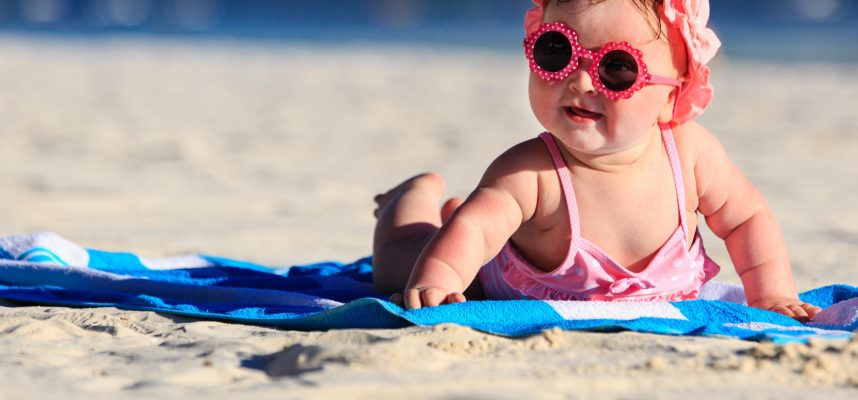
Keeping your baby safe in the sun
A little sunshine is good for everyone. But too much sun can be harmful for your baby. It can hurt your baby’s skin and eyes and make him feel sick.
Don’t think you have to keep your baby inside all the time, though. There are things you can do to help protect your little one while you enjoy time outdoors.
How can the sun harm your baby’s skin?
A baby’s skin is thin and burns much more easily than an older child’s skin. This is especially true for babies younger than 6 months. When the sun’s rays reach your baby’s skin, they can cause sunburn, blisters and other skin damage. It doesn’t matter how light or dark your baby’s skin is — the sun can damage it.
The sun’s rays are harmful even when it’s cloudy outside. Even if your baby doesn’t have sunburn that you can see, she may still have damage from the sun. Most sun damage comes from being in the sun while going about daily life, not from spending time at the beach.
Sun damage during childhood can lead to these skin problems later in life:
- Freckling or toughening of the skin
- Wrinkles
- Skin cancer
What are signs and symptoms of mild sunburn?
Your baby can get sunburn from spending just 15 minutes in the sun. He may not show signs of sunburn until 6 to 12 hours later.
Signs and symptoms of mild sunburn include:
- Red, warm and painful burn on the skin
- Itchy skin
To treat mild sunburn:
- Take your baby out of the sun
- Bathe your babyin cool (not cold) water.
- Put aloe vera gel or a cool compress on the burn. To make a cool compress, soak a cloth in cool water. Then wring it out before gently pressing to your baby’s skin.
- Give your baby acetaminophen (Tylenol®) to help ease any pain. The package lists the right amount for your baby’s age and weight.
- If you need to take your baby outside, cover any sunburned skin. Do this until his skin heals to prevent more pain and problems.
What are signs and symptoms of severe sunburn?
Signs and symptoms of severe sunburn include:
- Sunburn that’s widespread over the body
- Very painful sunburn or blisters
- Fever or chills
- Headache, confusion, feeling faint
- Nausea (feeling sick to your stomach)
- Swollen face
- Dehydration (not having enough water and fluids in your body)
To treat severe sunburn, call your baby’s health care provider or get emergency medical care. Severe sunburn is treated like any other serious burn. This may mean your baby needs to go to a hospital for treatment.
How can the sun harm your baby’s eyes?
Your baby’s eyes don’t block the sun’s rays as well as adult eyes do. Most sun damage to the eyes builds up over time. Sun damage to the eye during childhood can lead to these problems later in life:
- Cancer of the eyelid
- This is when your eye’s lens becomes cloudy. The lens is the part of the eye that helps your eye focus. Cataracts make your vision blurry.
- Sunburned corneas. The cornea is the clear, outermost layer of the eye.
- Macular degeneration. This condition slowly destroys the macula, the part of the eye that gives you sharp, central vision. It’s a common condition among people age 50 and older. Macular degeneration is the leading cause of vision loss in older adults.
How can you prevent sun damage for your baby?
Here’s how you can help keep your baby safe from the sun:
- Limit your baby’s time in the sun between 10 a.m. and 4 p.m. This is when the sun’s rays are the strongest. Keep your baby in the shade under a tree, an umbrella or other covering, especially if he’s younger than 6 months.
- Put your baby in a hat with a wide brim and baby sunglasses. Hats shade the face, and sunglasses protect your baby’s eyes. Look for sunglasses that have 99 percent UV protection. UV stands for ultraviolet. The sun gives off ultraviolet rays that can harm your baby.
- Dress your baby in lightweight clothes that cover his arms and legs. Choose clothes made from cloth that has a tight weave. This means that threads in the cloth are close together so that light can’t come through. To see if clothing has a tight weave, hold it up to a light. The less light that passes through the fabric, the tighter the weave.
- Put sunscreen on your baby, even on cloudy days. Sunscreen is a product that helps protect skin from sunburn. If your baby is older than 6 months, it’s safe to put sunscreen all over her body. If your baby is less than 6 months old, it’s best to keep her out of direct sunlight. But if you’re in the sun with no shade and your baby’s clothes and hat don’t fully protect her skin, use sunscreen on the parts of her body exposed to the sun, like her face and the backs of her hands.
What’s the best sunscreen for babies?
Pick a sunscreen with a label that says:
- It’s broad spectrum. This means it blocks two kinds of UV rays, called UVA rays and UVB rays. Most of the sun that we come in contact with comes from UVA rays. These can damage your baby’s skin. UVB rays can harm your baby’s skin and eyes and can weaken her immune system. The immune system protects your body from infection.
- It has a sun protection factor (SPF) of 15 or higher. The higher the SPF, the better it protects your baby’s skin from UVB rays.

